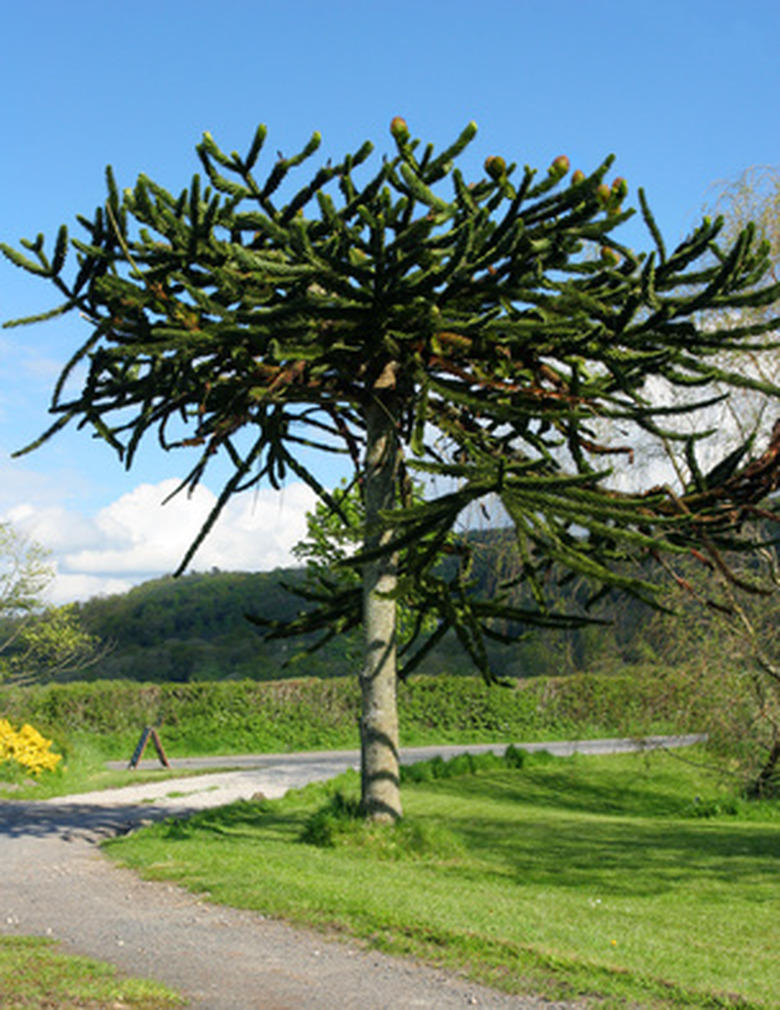Monkey Puzzle Tree Removal
Things Needed
- Leather gloves
- Long pants
- Long sleeves
- Hard hat
- Heavy-soled work boots
- Branch loppers
- Hand saw
- Axe
- Chainsaw
- Systemic herbicide
The monkey puzzle tree is a species of tree that is closely related to conifers that existed 300 million years ago during the Carboniferous period. The tree is native to Chile, where specimens more than 1,000 years old thrive. Collectors introduced it to England in 1795. There gardeners named it monkey puzzle tree because, due to the tree's sharp needles, climbing it would be a real puzzle for a monkey. Thanks to the same sharp needles, cutting down a monkey tree can also create a real puzzle for home owners.
Step 1
Put on heavy-duty leather gardening gloves and protective clothing that includes long sleeves, long pants, hard hat and close-toed shoes with thick soles to protect yourself from being injured by the needles of a monkey puzzle tree.
Step 2
Remove the lowest branches of a monkey puzzle tree with branch loppers or a hand saw to clear space for cutting down the tree. Young monkey puzzle trees have branches that may bend downward to the point that they touch the ground.
- The monkey puzzle tree is a species of tree that is closely related to conifers that existed 300 million years ago during the Carboniferous period.
- There gardeners named it monkey puzzle tree because, due to the tree's sharp needles, climbing it would be a real puzzle for a monkey.
Step 3
Examine the tree to determine if it has a natural leaning shape or asymmetrical canopy. Although monkey puzzle trees generally grow upright, an asymmetrical canopy or leaning shape can cause the tree to fall in the direction with the heaviest growth.
Step 4
Clear away any debris or objects from around the area where the tree will fall to keep it from damaging them when it falls. Remove any stones, roots or other obstacles along an escape path leading away from the tree.
Step 5
Make a wedge-shaped cut in the tree near the bottom of the trunk with an axe or chainsaw. The cut should open at a 45-degree angle in the direction that you want the tree to fall and should only extend a third of the way through the tree.
Step 6
Make a thin cut in the opposite side of the trunk from the wedge-shaped cut. This second cut should be slightly higher than the point of the wedge shaped cut and should extend two-thirds of the way through the tree. The tree will begin to tilt and fall in the direction of the larger wedge-shaped cut.
- Examine the tree to determine if it has a natural leaning shape or asymmetrical canopy.
- The cut should open at a 45-degree angle in the direction that you want the tree to fall and should only extend a third of the way through the tree.
Step 7
Step back along the escape path so that you will be out of the way from the falling tree and any falling debris. Wait for all debris to settle before returning to the fallen tree.
Step 8
Stand across from the limbs of a tree as you cut them. Saw through the limbs so that you remove them flush with the trunk of the tree.
Step 9
Cut the trunk of the tree in sections by cutting straight through the tree from the top to the bottom if the tree is on level ground. For a tree trunk that is elevated or on uneven ground, saw through the bottom third of the trunk. Then saw through the top two-thirds of the trunk. Cutting a trunk into sections will keep the weight of the trunk from binding the blade.
- Step back along the escape path so that you will be out of the way from the falling tree and any falling debris.
- Saw through the limbs so that you remove them flush with the trunk of the tree.
Step 10
Kill the stump by applying a spray of a systemic herbicide such as glyphosate. Systemic herbicides will pull poison into the roots of the tree stump and kill it. This will prevent the tree from producing new seedlings, which are known as suckers. You can then choose to remove the stump by grubbing or leave it in place to rot naturally. Grubbing is a process of digging a trench around the stump that is 2 feet wide by 2 feet deep. Cut each lateral root as you encounter it. Then push the stump over on its side and cut the roots on the underside of the stump. Once you cut all the roots, you can lift the stump free and fill in the hole left behind with soil. Grubbing works best on smaller trees. Large trees with taproots are difficult to remove by grubbing.
- Kill the stump by applying a spray of a systemic herbicide such as glyphosate.
- Systemic herbicides will pull poison into the roots of the tree stump and kill it.
Tip
Cut any bent branches as well as any saplings that have been pinned by the tree at the top of their bent arch so that they do not snap back and injure you. Always stand uphill to cut a tree that has fallen on a slope so that the tree does not roll onto you.
Warning
Always wear a hard hat when felling a tree. Never use a chainsaw at an angle that is higher than your shoulders. Doing so could cause you to lose control of the chainsaw.
